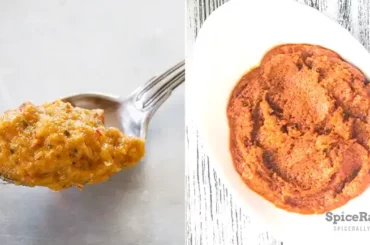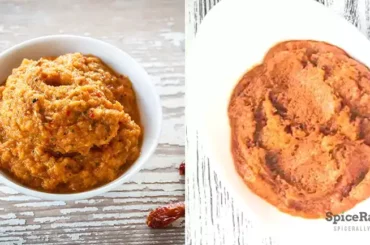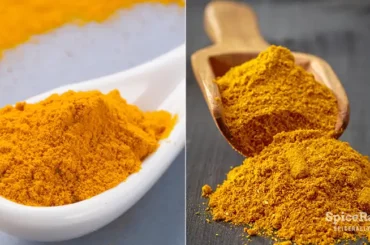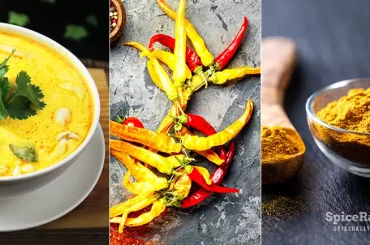Those eager to learn about different Thai curry pastes are highly confused about panang and massaman curry paste. So, here’s your guide to Thai Panang curry paste vs Thai Massaman curry paste.
Thai panang curry paste tends to be milder and comparatively less hot to the bite than the Thai massaman curry paste. It also contains more spices, giving a more robust flavor compared with the panang curry paste. On the other hand, panang curry paste is creamier and nuttier, giving a sweeter undertone to the curries and other dishes it is used in.

Let’s dig in and see further how these two curry pastes distinguish from each other and how these differences and similarities can help you choose.
Thai Panang Curry Paste vs Thai Massaman Curry Paste- SpiceRally Drill Down
| Thai Panang Curry Paste | Thai Massaman Curry Paste | |
|---|---|---|
| Base ingredients | Fresh and dried herbs and spices | Fresh and dried herbs and spices |
| Ingredients used | Fresh and dried mild thai chiles Galangal Lemongrass Cumin Nutmeg Kaffir lime peel and leaves Garlic Peanuts Coriander seeds Shrimp paste Black/white peppercorns Shallots Green cardamom Coriander roots Salt Some variations might also include the following: Mung beans Avocado oil/soybean oil/ vegetable oil Star anise Maple syrup Peanut butter Cloves Chickpea paste or Miso paste Cinnamon Mace Commercially-made products may have preservatives and additives | Thai red chiles Coriander seeds Cumin Lemongrass Coriander root Green cardamom Cinnamon Cloves Nutmeg Mace White pepper Garlic Galangal Shrimp paste Kaffir lime zest Salt Some variations might also include the following: Fish sauce Palm sugar Bay leaves Tamarind paste Shop-bought options may contain additives and preservatives |
| Flavor profile | Has a depth of flavor thanks to the combination of fresh and dried herbs and spices. The mild Thai red chiles give a touch of heat, not overwhelmed by the taste of spices. Has a sweeter, richer, and creamier undertone when compared with the massaman curry paste. | Packs a punch owing to the delicious combination of fresh and dried spices and herbs. Is spicier and hotter than the panang curry paste with touches of Indian and Middle Eastern spices. Less sweet than the panang curry paste with tangy and sour undertones. |
| Color | Reddish-brown in color | Usually has a brownish-orange color |
| Texture | Typically a coarse paste, depending on how much the mixture is ground | Typically a coarse paste, depending on how much the mixture is ground |
| Heat Level | Less hot than massaman curry paste | Can be hotter than the massaman curry paste |
| Level of spiciness | Typically less spicy than the massaman curry paste but the level of spiciness can be equalized if extra spices are included. | Spicier than the panang curry paste due to the combination of a variety of spices. |
| Main cooking application | Panang chicken and pork curries | Massaman chicken and beef curries |
| Other uses | – As a base for soups, stews, and stir-fries – To be included in spreads for sandwiches, burgers, and crackers – To include in dipping sauces, curry sauces, gravies, and salad dressings – To mix with roasted vegetables and egg dishes – When making savory rice and noodle dishes | – When making savory rice and noodle dishes – As a base for soups, stews, and stir-fries – To mix with roasted vegetables and egg dishes – To include in dipping sauces, curry sauces, gravies, and salad dressings – To be included in spreads for sandwiches, burgers, and crackers |
| Category of culinary ingredient | Cooking ingredient | Cooking ingredient |
| Availability | – Can be readily bought from anywhere in Thailand – Can be bought from certain online sellers, major online sites, and Asian stores outside of Thailand | – Can be readily bought from anywhere in Thailand – Can be bought from certain online sellers, major online sites, and Asian stores outside of Thailand |
| Storage | – Unopened, store-bought products can be kept outside at room temperature. – Opened shop-bought products and homemade ones should be refrigerated or frozen after every use to have a longer shelf life. | – Unopened, store-bought products can be kept outside at room temperature. – Opened shop-bought products and homemade ones should be refrigerated or frozen after every use to have a longer shelf life. |
| Mode of Production | Homemade and commercially made varieties exist | Homemade and commercially made varieties exist |
| Variations | No special variations exist but sometimes the recipes might have slight differences depending on the maker or production. | No special variations exist but sometimes the recipes might have slight differences depending on the maker or production. |
| Origin | Central or Northern Thailand | South of Thailand |
Diving Deeper Into The Difference Between Thai Panang Curry Paste And Thai Massaman Curry Paste
If you have visited a Thai restaurant, we are sure you have seen both panang and massaman curries on the menu.
Most of you may have tasted them both and still wonder how they differ. These curries have apparent differences and the main reason for their difference lies within the signature curry pastes used in each dish, which is their primary flavoring component.
Suppose you bring both the massaman curry paste and panang curry paste to your home. In that case, it is very important to know their differences and similarities when using various cooking applications. The first difference between these two curry pastes is their primary usage.
Content-wise Differences…
As you see, panang curry paste is specifically used to make traditional Thai panang curries while massaman curry paste is the main flavor component of massaman curries. Panang curries are considered to have original central or northern Thai origins.
On the other hand, massaman curries tend to have origins in Persia, India, and the influence of the Muslim minority of Thailand. This hugely impacts the curry paste, making the massaman curry have bolder taste elements influenced by Indian and middle eastern cuisines.
Therefore, most spices used in the massaman curry paste are not familiar to Thai cuisine. However, panang curry paste also contains spices that are similar to massaman curry paste. But still, panang curry paste does not typically contain spices like mace, cinnamon, and cloves which we usually see in the massaman curry paste.
Differences in Flavor and Usage
Panang curry paste is known for its milder and sweeter overtones. It is usually made with very mild Thai chiles, while the Massaman curry paste is a bit more powerful with hotter chiles. As represented to you in the table above, panang curry paste also contains peanuts, which is one of its main ingredients to give this curry paste a creamier texture and taste.
All facts considered, we can say that the massaman curry paste has a bolder and spicier taste, while the panang curry paste holds a depth of flavor but with a milder, more sweet, and creamier undertone. Nevertheless, apart from the main use, other cooking applications of both curry pastes do not differ much.
Due to the Muslim influence of the massaman curry paste, massaman curries are not typically made using pork. So, they are usually made with beef and chicken. On the contrary, panang curries are primarily made with pork (known as the Panang Moo) and chicken.
Can Thai Panang Curry Paste Be Used In Place Of Thai Massaman Curry Paste And Vice Versa?
Thanks to the similarities in the base flavor of these two curry pastes, Thai Panang curry paste can be a good substitute to be used in place of Thai massaman curry paste and vice versa. The obvious fact is that they cannot be replaced with each other in terms of their primary cooking application.
Thai massaman curry paste is not suitable for Thai panang curries and the panang curry paste is not a good match for traditional massaman curries. However, since you don’t usually find peanuts in the massaman curry paste, those who have nut allergies should be careful if using panang curry paste instead of the massaman curry paste.
Other than that, both can be great alternatives in place of each other and the amounts of substitution are dependent on the dish and preference.
Related Topics
- Thai Panang Curry Paste vs Thai red curry paste- Revealing The Differences and Similarities
- Thai Massaman Curry Paste vs Thai Yellow Curry Paste: A Better Comparison Of The Two Curry Pastes!
- Thai Massaman Curry Paste vs Thai Red Curry Paste: Revealing The Real Difference




